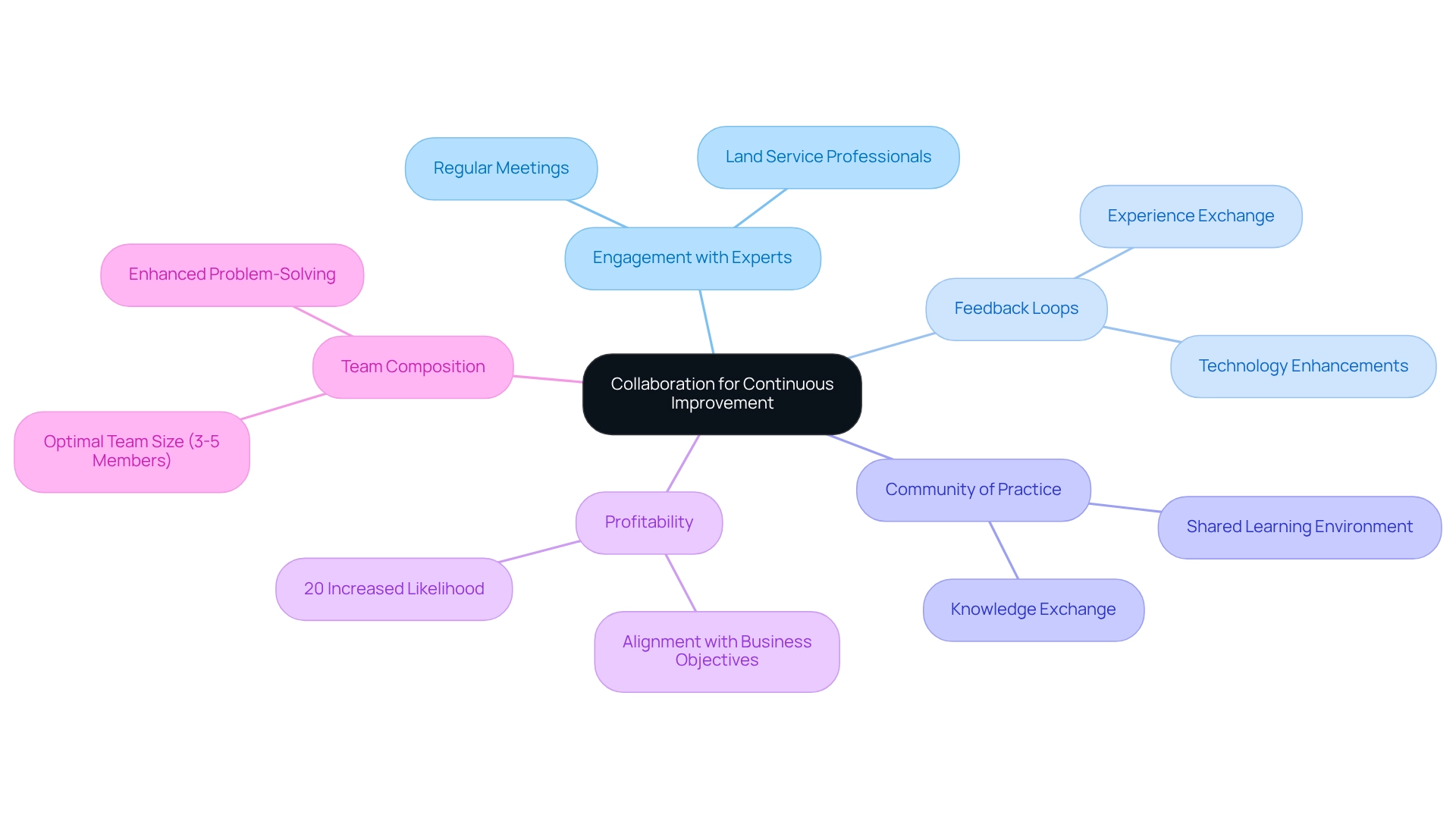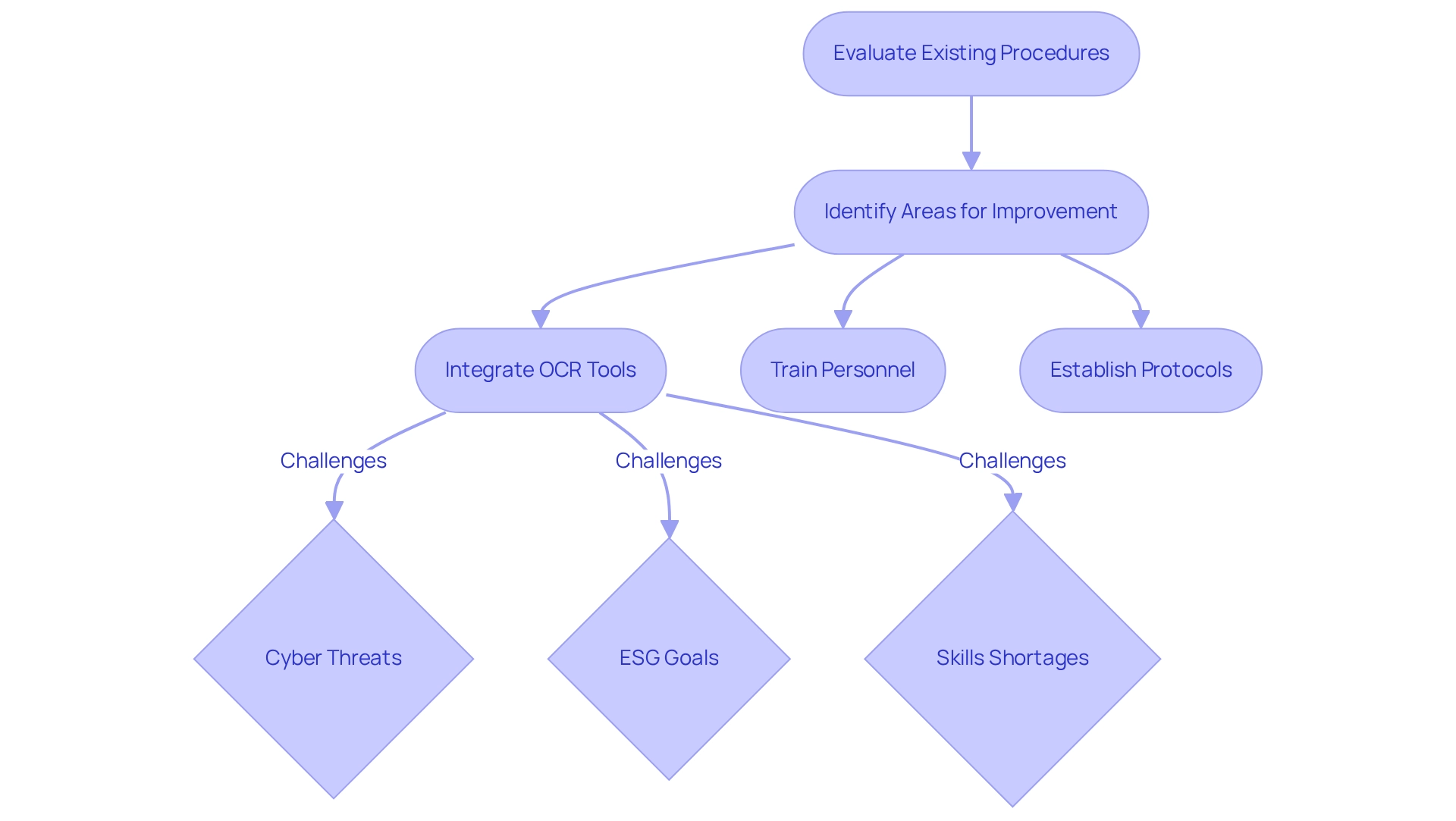Overview
Digital solutions for chain of title analysis, including machine learning algorithms and optical character recognition (OCR), play a crucial role in enhancing efficiency within real estate transactions. By streamlining workflows and improving data accuracy, these technologies address the pressing need for reliable title research. Furthermore, by integrating these advancements into existing practices, title researchers can automate repetitive tasks. This shift allows them to concentrate on advanced analysis, ultimately delivering more dependable results to clients in an increasingly competitive market.
Introduction
The realm of title research is undergoing a revolutionary transformation, propelled by technological advancements and the pressing demand for efficiency in real estate transactions. As title researchers adopt innovative tools such as machine learning and optical character recognition (OCR), they are fundamentally changing the methods by which property ownership is verified and analyzed. This evolution not only streamlines workflows but also significantly enhances productivity, enabling professionals to concentrate on strategic decision-making instead of repetitive tasks.
However, the path toward digital transformation is fraught with challenges, as many encounter obstacles that impede the adoption of these vital technologies. By comprehending the digital landscape, leveraging advanced solutions, collaborating with industry experts, and implementing effective strategies, title researchers can position themselves at the forefront of this dynamic field, ultimately delivering reliable results in an increasingly competitive market.
Understand the Digital Landscape for Title Analysis
The digital environment for property analysis is undergoing significant transformation, driven by digital solutions for chain of title analysis, technological advancements, and the pressing demand for efficiency in . Title researchers are increasingly leveraging digital solutions for chain of title analysis, such as machine learning algorithms and optical character recognition (OCR) systems, which facilitate the verification of property ownership. These technologies enable experts to extract and analyze data from documentation with exceptional speed and accuracy, ultimately reducing operational efforts and enhancing overall productivity, especially as current trends indicate a growing reliance on digital solutions for chain of title analysis and predictive modeling, which are becoming indispensable to the investigative process.
Notably, 22% of professionals cite economic uncertainty as a barrier to implementing digital transformations, underscoring the challenges that investigators face in harnessing these vital tools. Additionally, case studies illustrate that search engines remain a primary source of information, with 81.5% of online adults utilizing them monthly. This reliance on search engines underscores their critical role in information retrieval and illustrates how digital solutions for chain of title analysis can improve the effectiveness of research workflows.
By embracing these innovations, researchers can not only streamline their workflows but also deliver more reliable results to clients, thereby positioning themselves favorably in a swiftly evolving market. Staying abreast of these advancements is essential for maximizing the full potential of digital solutions in document analysis.
Leverage Advanced Technologies for Efficient Title Research
To enhance efficiency in title research, experts must leverage advanced methodologies such as machine learning and optical character recognition (OCR). Machine learning algorithms are adept at analyzing vast datasets, facilitating the identification of patterns and discrepancies within record collections. This capability is particularly advantageous for automating the detection of ownership changes, which significantly reduces the time required for manual reviews. Meanwhile, OCR systems swiftly convert scanned documents into modifiable and searchable formats, thereby improving the document analysis process.
Integrating these innovations into existing workflows empowers professionals to concentrate on advanced analysis and strategic decision-making, rather than being encumbered by repetitive tasks. For instance, the implementation of OCR technology has demonstrated a marked enhancement in search capabilities, enabling users to efficiently locate specific documents and information, thereby minimizing the time spent on document retrieval.
Real-world applications, such as those showcased by Parse AI, exemplify the substantial cost savings and improved accuracy achievable through these innovations. By harnessing machine learning and OCR, professionals in the field can markedly enhance their operational efficiency, ultimately leading to improved service delivery and in the evolving landscape of .
Collaborate with Professionals for Continuous Improvement
Collaborating with experts in the real estate and research sectors is essential for continuous improvement. Engaging with land service professionals allows researchers to identify common challenges, such as incomplete records and discrepancies in ownership data. By establishing regular meetings and feedback sessions, an environment of shared learning is fostered, where best practices can be developed and refined.
For instance, implementing a feedback loop where researchers exchange their experiences with new technologies can reveal opportunities for enhancements and innovations. This collaborative approach not only improves the efficacy of document examination but also cultivates a community of practice that promotes ongoing professional development through the exchange of knowledge and resources.
Research indicates that organizations with of collaboration are 20% more likely to achieve profitability, underscoring the critical role of teamwork in achieving business objectives within the research domain. Furthermore, empowering decision-makers can increase the likelihood of success by 3.9 times, illustrating how such authority can enhance teamwork and problem-solving in navigating the complexities of document analysis.
Additionally, studies show that teams comprising 3 to 5 members excel in addressing complex issues, highlighting the effectiveness of smaller collaborative groups in tackling the intricate challenges faced in research. A case study from a leading firm demonstrated that by conducting regular collaborative sessions with land service experts, they successfully reduced discrepancies in ownership records by 30%, showcasing the tangible benefits of collaboration in this field.

Implement Digital Solutions into Existing Workflows
To fully leverage the advantages of digital solutions for chain of title analysis, title researchers must strategically integrate these digital solutions into their existing workflows. An essential initial measure is to evaluate existing procedures, identifying areas where advancements can greatly improve efficiency. For instance, the integration of Optical Character Recognition (OCR) tools into can automate data entry, leading to reduced errors and substantial time savings. Statistics indicate that organizations implementing OCR have seen success rates in document processing accuracy soar, with some achieving over 90% accuracy in reading handwritten text, contingent on legibility.
Furthermore, training personnel on new innovations is essential for facilitating seamless integration and optimizing their capabilities. Establishing clear protocols for the use of digital tools promotes consistency and quality in research outputs. Moreover, a phased approach to implementation allows researchers to gradually adapt to new technologies, minimizing disruption to operations. This method not only facilitates a smoother transition but also helps in addressing common challenges such as cyber threats, ESG goals, and skills shortages that can hinder digital transformation efforts. By embracing these strategies, title companies can utilize digital solutions for chain of title analysis to enhance their workflows and achieve significant improvements in efficiency and accuracy.

Conclusion
The transformation of title research through digital technologies signifies a pivotal shift in the real estate sector, enhancing efficiency and accuracy in property ownership verification. By leveraging advanced tools such as machine learning and optical character recognition (OCR), title researchers streamline workflows, reduce operational burdens, and focus on strategic decision-making. Furthermore, the integration of these technologies accelerates the analysis process and empowers professionals to deliver reliable results, thereby gaining a competitive edge in a rapidly evolving market.
However, the journey toward digital adoption is fraught with challenges. Many title researchers encounter barriers such as economic uncertainty and incomplete records. Consequently, collaboration with industry professionals emerges as a crucial strategy for overcoming these hurdles. By fostering an environment of shared learning and continuous improvement, title researchers refine their practices, enhance problem-solving capabilities, and ultimately drive better outcomes for their clients.
To fully capitalize on the benefits of digital solutions, a strategic approach to implementation is essential. Assessing current workflows, training staff, and establishing clear protocols facilitate a seamless transition to new technologies. As title researchers embrace these advancements, they position themselves not only as efficient service providers but also as innovators in the title research landscape. The commitment to leveraging technology, collaborating with peers, and continuously improving practices ensures that title researchers remain at the forefront of this dynamic field, ready to meet the demands of an increasingly competitive market.
Frequently Asked Questions
What is driving the transformation of the digital environment for property analysis?
The transformation is driven by digital solutions for chain of title analysis, technological advancements, and the demand for efficiency in real estate transactions.
What technologies are title researchers using for chain of title analysis?
Title researchers are increasingly using machine learning algorithms and optical character recognition (OCR) systems to facilitate the verification of property ownership.
How do these technologies improve the analysis process?
These technologies enable experts to extract and analyze data from documentation with exceptional speed and accuracy, reducing operational efforts and enhancing overall productivity.
What percentage of professionals view economic uncertainty as a barrier to digital transformation?
22% of professionals cite economic uncertainty as a barrier to implementing digital transformations.
How significant are search engines in the information retrieval process for property analysis?
Search engines are a primary source of information, with 81.5% of online adults utilizing them monthly, highlighting their critical role in information retrieval.
What benefits do digital solutions for chain of title analysis provide to researchers?
By embracing digital innovations, researchers can streamline their workflows and deliver more reliable results to clients, positioning themselves favorably in a rapidly evolving market.
Why is it important for researchers to stay updated on digital advancements?
Staying abreast of these advancements is essential for maximizing the full potential of digital solutions in document analysis.




